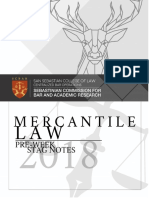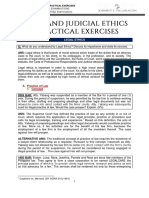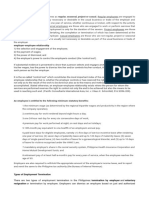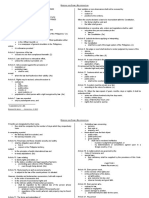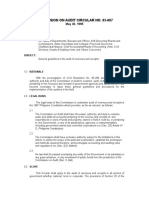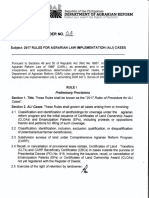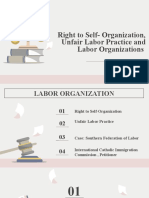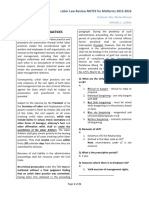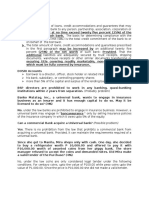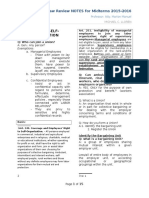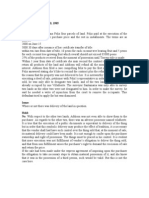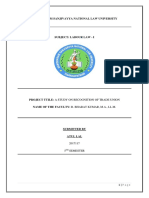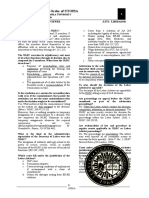Manuel Notes
Uploaded by
MichaelManuel Notes
Uploaded by
MichaelLabor Law Review NOTES for Finals 2015-2016
Professor: Atty. Marlon Manuel
MICHAEL C. LLOREN
UNFAIR LABOR PRACTICES
Article 253. Concept of unfair labor
practice
and
procedure
for
prosecution
thereof. Unfair
labor
practices violate the constitutional
right of workers and employees to selforganization, are inimical to the
legitimate interests of both labor and
management, including their right to
bargain collectively and otherwise
deal with each other in an atmosphere
of freedom and mutual respect,
disrupt industrial peace and hinder the
promotion of healthy and stable labormanagement relations.
Consequently, unfair labor practices
are not only violations of the civil
rights of both labor and management
but are also criminal offenses against
the State which shall be subject to
prosecution and punishment as herein
provided.
Subject to the exercise by the
President or by the Secretary of
Labor and Employment of the powers
vested in them by Articles 263 and
264 of this Code, the civil aspects of
all cases involving unfair labor
practices, which may include claims
for actual, moral, exemplary and
other
forms
of
damages,
attorneysfees
and
other
affirmative relief, shall be under
the jurisdiction of the Labor
Arbiters. The Labor Arbiters shall give
utmost priority to the hearing and
resolution of all cases involving unfair
labor practices. They shall resolve
such cases within thirty (30) calendar
days from the time they are
submitted for decision.
Recovery
of
civil
liability
in
administrative proceedings shall bar
recovery under the Civil Code.
No criminal prosecution under this
Title may be institutedwithout a
final judgment finding that an
unfair
labor
practice
was
committed,
having
been
first
obtained in the preceding paragraph.
During
the
pendency
of
such
administrative proceeding, the running
of the period of prescription of the
criminal offense herein penalized shall
be considered interrupted: Provided,
however, that the final judgment in
the administrative proceedings shall
not be binding in the criminal case nor
be considered as evidence of guilt but
merely as proof of compliance of the
requirements therein set forth. (As
amended by Batas PambansaBilang
70, May 1, 1980 and later further
amended by Section 19, Republic Act
No. 6715, March 21, 1989)
Q: What are the Unfair Labor
Practice (ULP)'s in CB?
A:
1. Refusal to bargain - refusal to
reply to proposal
2. Individual bargaining - can only
bargain with EBR
3. Bad faith bargaining - must be
raised while bargaining is in the
process; based on facts
4. Blue
sky
bargaining
exaggerated and unreasonable
proposals in CB
5. Surface bargaining - cosmetic
pretence of bargaining
Q: Elements of ULP?
A:
1. Existence of Er-Ee Relationship
the
Page 1 of 24
Labor Law Review NOTES for Finals 2015-2016
Professor: Atty. Marlon Manuel
MICHAEL C. LLOREN
2. Defined in the labor code as
ULP1
Note: enumerations under LC is
not exclusive
Q: What
period?
A: 1 year
is
the
prescriptive
Q: Instances where there is no
Employer ULP
A:
1. Valid
exercise
of
management rights.
2. Interest
of
company
company can promote, transfer
or demote its employees.
3. Treat Union and non-union
employees differently. (only
unlawful IF it is done against
the right to self-organization)
Q: What are the Unfair Labor
Practices of Employers?
Article 254. Unfair labor practices of
employers. It shall be unlawful for an
employer to commit any of the
following unfair labor practice:
To interfere with, restrain or coerce
employees in the exercise of their
right to self-organization;
To require as a condition of
employment that a person or an
employee shall not join a labor
organizationor shall withdraw from
one to which he belongs;
To
contract
out
services
or
functions being performed by
union members when such will
interfere with, restrain or coerce
employees in the exercise of their
rights to self-organization;
To initiate, dominate, assist or
otherwise
interfere
with
the
1
formation or administration of any
labor organization, including the
giving of financial or other support to
it or its organizers or supporters;
To discriminate in regard to wages,
hours of work and other terms and
conditions of employment in order to
encourage or discourage membership
in any labor organization. Nothing in
this Code or in any other law shall stop
the parties from requiring membership
in a recognized collective bargaining
agent as a condition for employment,
except those employees who are
already members of another union at
the time of the signing of the
collective
bargaining
agreement.
Employees
of
an
appropriate
bargaining unit who are not members
of the recognized collective bargaining
agent may be assessed a reasonable
fee equivalent to the dues and other
fees paid by members of the
recognized
collective
bargaining
agent, if such non-union members
accept the
benefits
under the
collective
bargaining
agreement:
Provided,
that
the
individual
authorization required under Article
242, paragraph (o) of this Code shall
not apply to the non-members of the
recognized
collective
bargaining
agent;
To dismiss, discharge or otherwise
prejudice or discriminate against an
employee for having given or being
about to givetestimony under this
Code;
To violate the duty to bargain
collectively as prescribed by this
Code;
To
pay
negotiation
or
attorneysfeesto the union or its
officers or agents as part of the
settlement of any issue in collective
bargaining or any other dispute; or
To violate a collective bargaining
Page 2 of 24
Labor Law Review NOTES for Finals 2015-2016
Professor: Atty. Marlon Manuel
MICHAEL C. LLOREN
agreement.
The provisions of the preceding
paragraph notwithstanding, only the
officers and agents of corporations,
associations or partnerships who have
actually participated in, authorized or
ratified unfair labor practices shall be
held criminally liable. (As amended by
Batas PambansaBilang 130, August
21, 1981)
1. INTERFERENCE
interfering with formation of
union, such as threatening pay
cuts for Employees who join the
union
dismissal of union members
upon refusal to give up
membership
refusal
to
give
salary
adjustments according to CBA
scale for years
lock out or closure amounting
to ULP
sale of enterprise in bad faith
- The GENERAL RULE is
that labor contracts are in
personam
and
not
binding to the transferee
(BUYER).
However,
if
there is BAD FAITH it can
be enforced even against
the transferee
Q: What is the doctrine of
successor-employer?
A: A company that engaged in the
same business as the closed
company and is owned by the same
people is treated as a continuation of
the one that closed.
2. YELLOW DOG CONTRACT
it is a promise extracted from
an employee that as a condition
for employment they MUST NOT
join any union.
3. CONTRACTING OUT AS ULP
it is the contracting out of
services performed by union
members as to interfere with
right to self-organization.
Instance where it is not ULP:
- Done for business reason
(Ex. save cost, decline in
business, or inadequate
equipments, etc.)
- RUNWAY SHOP - it is the
transfer of business to
discriminate
against
union members in old
plant.
4. COMPANY COMINATION OF
UNION
Initiation of company union idea
- Outright formation by the
ER
- EE formation due to ER
demand
- managerial
motivated
formation my EE
Financial support to union
ER
encouragement
and
assistance
- Ex:
giving
exclusive
recognition
as
EBR
without determining if it
represents majority of
EEs
Supervisory assistance
5. DISCRIMINATION
Must be in the terms of the
employment or treatment of the
unions members vis-a- vis the
non members
Means of :
BONUS ALLOCATION; or
Page 3 of 24
Labor Law Review NOTES for Finals 2015-2016
Professor: Atty. Marlon Manuel
MICHAEL C. LLOREN
LAYOFF - even if there is a valid
basis for layoff, but ALL those
affected are UNION members
TEST OF DISCRIMINATION:
underlying reason is union
activities
Q: What is a UNION SECURITY
CALUSE?
A: A valid discrimination favoring
unionism.
New
employees
are
compelled to join the union.
Q:
What
if
the
employer
terminates who does not join is it
ULP?
A: NO under union security clause.
Q: What are the different kinds of
union security clause?
A:
Close
shop;
Union
Shop;
Maintenance of Membership; etc.
Q: Are there employees not
covered by the closed shop
provision?
A: YES.
a) Those at the time of the closedshop agreement is a member of
a
religion
that
prohibits
members from joining unions.
(Ex. INC)
b) Already
in
service
and
members of a labor union
c) Confidential employees
d) Those excluded by agreement
NOTE: General Rules, CLOSE SHOP
ONLY applies to new employees.
Q: What is agency shop?
A: It is where the employee is not
required to join the union but has to
pay the union service fee.
6. DISCRIMINATION
DUE
TO
TESTIMONY
A retaliatory act of the employer
7. VIOLATION OF DUTY TO
BARGAIN
a) Failure or refusal to meet
or convene;
b) Evading
mandatory
subjects;
c) Bad faith;
d) Gross violation of the CBA
Q: What are mandatory subjects
of the CBA?
A:
1. Grievance machinery
2. Voluntary Arbitration
8. PAID NEGOTIATIONS
ER cannot pay in own volition,
nor can EE as or accept
payments
9. GROSS VIOLATION OF THE
CBA
Q: EE is not being paid OT pay, is
it ULP?
A: Not, necessarily it must be coupled
with the reason to discourage the EE
to join labor organizations.
Q:
Can
ULP
cases
be
compromised?
A: No, they are coupled with public
interest.
Q: What is the SINGLE CHARGE
rule?
A: It means there should be no
splitting of cause of action.
Q: What are available reliefs?
A:
1. Cease and desist order
2. Affirmative order
3. Order to bargain or imposition
of the CBA
Page 4 of 24
Labor Law Review NOTES for Finals 2015-2016
Professor: Atty. Marlon Manuel
MICHAEL C. LLOREN
4. Strike
Q: What are ULP of unions?
A:
Article 249. Unfair labor practices of
labor organizations. It shall be unfair
labor practice for a labor organization,
its officers, agents or representatives:
To restrain or coerceemployees in
the exercise of their right to selforganization. However, a labor
organization shall have the right to
prescribe its own rules with respect to
the
acquisition
or retention
of
membership;
To cause or attempt to cause an
employer to discriminate against
an
employee,
including
discrimination
against
an
employee with respect to whom
membership in such organization has
been denied or to terminate an
employee on any ground other than
the usual terms and conditions under
which membership or continuation of
membership is made available to
other members;
To violate the duty, or refuse to
bargain
collectively
with
the
employer,
provided
it
is
the
representative of the employees;
To cause or attempt to cause an
employer to pay or deliver or
agree to pay or deliver any money
or other things of value, in the
nature of an exaction, for services
which are not performed or not to be
performed, including the demand for
fee for union negotiations;
To ask for or accept negotiation or
attorneys fees from employers as
part of the settlement of any issue
in collective bargaining or any other
dispute; or
To violate a collective bargaining
agreement.
The provisions of the preceding
paragraph notwithstanding, only the
officers,
members
of
governing
boards, representatives or agents or
members of labor associations or
organizations who have actually
participated in, authorized or ratified
unfair labor practices shall be held
criminally liable. (As amended by
Batas PambansaBilang 130, August
21, 1981)
1. RESTRAINT OR COERCION BY
LABOR ORGANIZATIONS
Unions cannot coerce EE's to
join a strike
Note: Interference of EE dose
not amount to ULP, UNLESS it
amount to coercion or retraint.
2. UNION-INDUCED
DISCRIMINATION
Union security clause used
arbitrarily
3. REFUSAL TO BARGAIN
Ex: entering negotiations with
fixed purpose of not reaching an
agreement.
4. FEATHERBEDDING
AND
MAKE-WORK
ARRANGEMENTS
featherbedding is a practice
of EEwhere they
create or
spread
employment
by
unnecessarily maintaining or
increasing the number of EEs
used,amount
of time consumed,orworkon a
particular job.
Make-work:
minimum-crew
regulations on railroads, setting
and prompt destruction of
bogus type in newspapers,
stand-by pay for musicians
Page 5 of 24
Labor Law Review NOTES for Finals 2015-2016
Professor: Atty. Marlon Manuel
MICHAEL C. LLOREN
when a radio station broadcasts
music from records, etc.
5. ASK
OR
ACCEPT
NEGOTIATION
OR
ATTORNEY'S FEED FROM ER
6. GROSS VIOLATION OF CBA
EMPLOYER
Interference
Yellow dog
Discrimination
Violation of duty
to bargain
Paid negotiations
Gross violation of
CBA
Contracting out as
ULP
Company
domination of
union
Discrimination
due to testimony
EMPLOYEE
Restraint or
coercion
Feather-bedding
and make work
arrangement
Union induced
discrimination
Refusal to bargain
Asking or
accepting
negotiations or
attorney's fees
Gross violation of
CBA
Page 6 of 24
Labor Law Review NOTES for Finals 2015-2016
Professor: Atty. Marlon Manuel
MICHAEL C. LLOREN
STRIKES AND LOCKOUTS
Article 263. Strikes,
lockouts.
picketing
and
It is the policy of the State to
encourage free trade unionism and
free collective bargaining.
Workers shall have the right to engage
in concerted activities for purposes of
collective bargaining or for their
mutual benefit and protection. The
right of legitimate labor organizations
to strike and picket and of employers
to lockout, consistent with the national
interest,
shall
continue
to
be
recognized and respected. However,
no labor union may strike and no
employer may declare a lockout on
grounds involving inter-union and
intra-union disputes.
In case of bargaining deadlocks, the
duly certified or recognized bargaining
agent may file a notice of strike or the
employer may file a notice of lockout
with the Ministry at least 30 day
before the intended date thereof. In
cases of unfair labor practice, the
period of notice shall be 15 days and
in the absence of a duly certified or
recognized bargaining agent, the
notice of strike may be filed by any
legitimate labor organization in behalf
of its members. However, in case of
dismissal from employment of union
officers duly elected in accordance
with the union constitution and bylaws, which may constitute union
busting, where the existence of the
union is threatened, the 15-day
cooling-off period shall not apply and
the
union
may
take
action
immediately.
(As
amended
by
Executive Order No. 111, December
24, 1986)
The notice must be in accordance with
such
implementing
rules
and
regulations as the Minister of Labor
and Employment may promulgate.
During the cooling-off period, it shall
be the duty of the Ministry to exert all
efforts at mediation and conciliation to
effect a voluntary settlement. Should
the dispute remain unsettled until the
lapse of the requisite number of days
from the mandatory filing of the
notice, the labor union may strike or
the employer may declare a lockout.
A decision to declare a strike must be
approved by a majority of the total
union membership in the bargaining
unit concerned, obtained by secret
ballot in meetings or referenda called
for that purpose. A decision to declare
a lockout must be approved by a
majority of the board of directors of
the corporation or association or of the
partners in a partnership, obtained by
secret ballot in a meeting called for
that purpose. The decision shall be
valid for the duration of the dispute
based on substantially the same
grounds considered when the strike or
lockout vote was taken. The Ministry
may, at its own initiative or upon the
request of any affected party,
supervise the conduct of the secret
balloting. In every case, the union or
the employer shall furnish the Ministry
the results of the voting at least seven
days before the intended strike or
lockout, subject to the cooling-off
period herein provided. (As amended
by Batas PambansaBilang 130, August
21, 1981 and further amended by
Executive Order No. 111, December
24, 1986)
When, in his opinion, there exists a
Page 7 of 24
Labor Law Review NOTES for Finals 2015-2016
Professor: Atty. Marlon Manuel
MICHAEL C. LLOREN
labor dispute causing or likely to cause
a strike or lockout in an industry
indispensable to the national interest,
the
Secretary
of
Labor
and
Employment may assume jurisdiction
over the dispute and decide it or
certify the same to the Commission for
compulsory
arbitration.
Such
assumption or certification shall have
the effect of automatically enjoining
the intended or impending strike or
lockout as specified in the assumption
or certification order. If one has
already taken place at the time of
assumption or certification, all striking
or locked out employees shall
immediately return-to-work and the
employer shall immediately resume
operations and readmit all workers
under the same terms and conditions
prevailing before the strike or lockout.
The
Secretary
of
Labor
and
Employment or the Commission may
seek
the
assistance
of
law
enforcement agencies to ensure
compliance with this provision as well
as with such orders as he may issue to
enforce the same.
In line with the national concern for
and the highest respect accorded to
the right of patients to life and health,
strikes and lockouts in hospitals,
clinics and similar medical institutions
shall, to every extent possible, be
avoided, and all serious efforts, not
only by labor and management but
government as well, be exhausted to
substantially minimize, if not prevent,
their adverse effects on such life and
health, through the exercise, however
legitimate, by labor of its right to
strike and by management to lockout.
In labor disputes adversely affecting
the continued operation of such
hospitals,
clinics
or
medical
institutions, it shall be the duty of the
striking union or locking-out employer
to provide and maintain an effective
skeletal workforce of medical and
other
health
personnel,
whose
movement and services shall be
unhampered and unrestricted, as are
necessary to insure the proper and
adequate protection of the life and
health of its patients, most especially
emergency cases, for the duration of
the strike or lockout. In such cases,
therefore, the Secretary of Labor and
Employment
may
immediately
assume, within twenty four (24) hours
from knowledge of the occurrence of
such a strike or lockout, jurisdiction
over the same or certify it to the
Commission
for
compulsory
arbitration. For this purpose, the
contending
parties
are
strictly
enjoined to comply with such orders,
prohibitions and/or injunctions as are
issued by the Secretary of Labor and
Employment or the Commission,
under pain of immediate disciplinary
action, including dismissal or loss of
employment status or payment by the
locking-out employer of backwages,
damages and other affirmative relief,
even criminal prosecution against
either or both of them.
The foregoing notwithstanding, the
President of the Philippines shall not
be precluded from determining the
industries that, in his opinion, are
indispensable to the national interest,
and from intervening at any time and
assuming jurisdiction over any such
labor dispute in order to settle or
terminate the same.
Before or at any stage of the
compulsory arbitration process, the
parties may opt to submit their
dispute to voluntary arbitration.
Page 8 of 24
Labor Law Review NOTES for Finals 2015-2016
Professor: Atty. Marlon Manuel
MICHAEL C. LLOREN
The
Secretary
of
Labor
and
Employment, the Commission or the
voluntary arbitrator shall decide or
resolve the dispute, as the case may
be. The decision of the President, the
Secretary of Labor and Employment,
the Commission or the voluntary
arbitrator shall be final and executory
ten (10) calendar days after receipt
thereof by the parties. (As amended
by Section 27, Republic Act No. 6715,
March 21, 1989)
Definitions:
STRIKE
It is a temporary stoppage of work by
concerted action arising from a labor
dispute between an employer and
employee.
LOCK OUT
It is a temporary refusal of ER to
furnish work as a result of industrial or
labor dispute.
CHARACTERISTICS OF A STRIKE:
1. ER-EE labor dispute
2. Employment relation is deemed
to continue although in a state
of belligerent suspension.
3. Temporary stoppage of work
through concerted action
NOTE:An employee on LOA cannot
engaged in a strike since he cannot
stop work since he is already not
working.
Q: What is a concerted action?
A: It is an activity undertaken by two
or more EE, by one on behalf of
others.
Q: When can you strike?
A: If there is:
1. ULP; or
2. Bargaining Deadlock
Q:
What
is
the
conversion
doctrine?
A: Instance where a valid strike
(Economic) is converted to ULP or
vice-versa.
Q: Who can strike?
A:
1. Exclusive
Bargaining
Representative (EBR) if there is
one
2. Any
Legitimate
Labor
Organization (LLO) if there is no
EBR
NOTES:
1. You can STRIKE even before the
CE via LLO
2. Registration
with
DOLE
is
necessary to conduct a STRIK
3. A chartered union cannot
conduct a strike prior to
registration to DOLE
4. A chartered local can conduct a
strike if it has submitted all the
requirements.
Q: Can there be a valid strike
without a UNION?
A: No
Q: What if a strike is initiated not
by a Labor union?
A: it is a strike BUT not a valid strike.
Q: Are violation of the CBA
automatically amounts to ULP?
A: No. It is necessary that it must be
coupled
with
malice.
(economic
provisions + malice)
Q: What happens if you conduct a
strike on the ground of grievance?
A: it is not a valid strike.
NOTE:There can be no strike if there
is no dispute with employer.
Page 9 of 24
Labor Law Review NOTES for Finals 2015-2016
Professor: Atty. Marlon Manuel
MICHAEL C. LLOREN
Q: Is welgangbayan a strike?
A: No, there is no ER-EE relationship, it
is a mere sympathy strike. However in
Biflex vs. filflex2 it was held that it is a
mass action that
could lead to a
possible dismissal.
Q: Is it proper to call it an illegal
strike?
A: No. It is not a strike, hence, it is not
necessary to determine if it is a valid
or illegal strike.
Cases:
NUWHRAIN-Duit Hotel vs. CA
- even without stoppage of work,
when the employees showed up baled
and the emplyer refused to let them
enter the hotel and give them work
was considered a strike.
Soriano Aviation vs. Employees
Association of A. Soriano
- employees refusal to work in 3
consecutive holidays were considered
a strike.
NOTE: A prayer rally is NOT a strike as
long as IT DOES NOT disrupt the work
of those in duty.
1. File a notice to strike to the
regional office of DOLE(first
notice)
o at
least:
(COOLING
OFF
PERIOD)
30 days before intended date of
strike if (CBA deadlock); or
15 days before intended date of
strike in (ULP)
Exception:
Union Busting (when a
officer of the union is
terminated)
Q: What is the purpose of the
Cooling off period?
A: Give opportunity to reconcile
(CONCILIATION)
2. Inform the DOLE at least
24hrs before the strike vote.
(second notice)
o This is to give time for the
NCMD to supervise the strike
vote
o This is done any time AFTER
giving the notice to strike.
Note: It is not necessary that
the union should wait for the
DOLE representative
Q: Is it necessary that there is
actual
ground
for
a
strike
otherwise, it is deemed an illegal
strike?
A: No. GOOD FAITH STRIKE may be a
raise, that a union in GOOD FAITH
believed that there is a ground to
strike, even if it is later found not to
have actually existed.
3. Hold Strike Vote
o Done after filling the notice of
strike
WHAT IS REQUIRED?
o Majority
vote
of
UNION
MEMBERS ONLY
Q: What is the procedure before
you can conduct a strike?
A:
5. Seven (7) day strike ban
o Counted from the time you
submitted the strike-vote results
4. Give notice of the result of
the strike vote(third notice)
PURPOSE:
Page 10 of 24
Labor Law Review NOTES for Finals 2015-2016
Professor: Atty. Marlon Manuel
MICHAEL C. LLOREN
allow the DOLE to confirm that
results of the vote, and allow
any party to contest the result.
Q: What if the strike ban is over
but the cooling off period is not,
can you strike?
A: No. you must wait for the expiration
of the strike ban.
Q: What if the strike ban is over
but the cooling off period is not,
can you strike?
A: No, you must wait for the expiration
of the cooling off period.
Q: Is it possible that the strike
ban is within the period of the
cooling off period?
A: Yes. The 7 day strike-ban is counted
from the period of the submission of
the strike vote results, and the strike
vote result can be conducted on the
earlier part of the application to strike.
Q: What would be the effect?
A: TWO THEORIES
1. According to atty. Manuel if the 7
days strike ban is absorbed or within
the cooling-off period after expiration
of the cooling-off period they can now
conduct a strike. (Basis: it is the
purpose of the strike ban)
2. According to atty. Azucena's book it
stated that in case the 7 day strike
ban would fall under the cooling-off
period it should be counted in addition
to the 30 or 15 days as the case may
be. (Basis: cited a circular)
Q: How many notices all are you
required to submit?
A: Three (3)
Q: What are the prohibited acts
during strike?
A:
1. Strike
or
lock-out
after
assumption of jurisdiction;
2. knowingly participating in an
illegal strike or committing
illegal acts during strike;
3. Obstruct, impede, or interfere
with
through
force,
violence,coercion, threats, or
intimidation
any
peacefulpicketing
4. Employment or strikebreaker or
being employed asstrikebreaker
5. Bringing in, introducing, or
escorting by public officer
oremployee (including AFP/PNP)
or
armed
persons
any
individual who seeks to replace
strikers
in
entering
or
leavingpremises
6. Commit any act of violence,
coercion,intimidation
whileengaging in picketing or
obstruction of ingress or egress
from
ERs
premises
for
lawful
purposes
or
obstruct
thoroughfares
Q: Is it necessary for the employer
to wait for a case to be filed in
order to fire an employee who
committed an illegal act? or wait
that the strike be declared illegal?
A: NO. the act is illegal, independent
of whether the strike is legal or not.
Q: when does a strike become
illegal based due to the acts of
the strikers?
A: Based on the circumstances that
surrounds the case.
NOTE:
Page 11 of 24
Labor Law Review NOTES for Finals 2015-2016
Professor: Atty. Marlon Manuel
MICHAEL C. LLOREN
A single or isolated act of violence
does not convert the strike as illegal.
The violence needs to be pervasive.
Hence, the culpability is not collective.
Q: What is improved offer balloting?
A: Instance when the Regional Branch
of board conducts referendum by
secret ballot on the ER's improved
offer in case of strike; or the BOD
conducts votes on the reduced offer.
Two (2) Situations:
1. In case of strike
Regional
Branch
of
board
conducts referendum by secret
ballot on the ER's improved
offer
on or before the 30 day of strike
when at least majority of union
members accept the improved
offer,
the
strikers
MUST
IMMEDIATELY return to work
2. In case of lockout
The BOD is the one that votes
on the reduced offer (Reduced
Offer Balloting)
Q: What are requisites of lawful
picketing?
A:
1. Aim is to inform the public
about the dispute;
2. Peacefully done;
NO threats, intimidation,
coercion,
force,
vandalism, or obstruction
of ingress/ egress
Q: What is assumption of
jurisdiction?
A: It is when the Secretary of labor
issues an assumption order and
assumes jurisdiction of the conflict
between employer and employees.
Q: Is it mandatory or
discretionary?
A: Both depending on the
circumstances:
1. Discretionary
Industries INDESPENSIBLE to
national interest
Sec. assumes jurisdiction or
certify to NLRC for compulsory
arbitration
EFFECT: Issuance of Return to
work order
2. Mandatory
Those
affecting
HOSPITALS,
CLINICS,
MEDICAL
INSTITUTIONS
Sec. assumes jurisdiction or
certify to NLRC for compulsory
arbitration
Responsibility of the EE/ER in
case of strike or lockout:
SKELETAL WORK FORCE
Assumption of jurisdiction from
court jurisdiction over the case
ASSUMPTION OF
COURT
JURSDICTION
JURISDICTION
Parties
do
not Parties initiate
initiate
Sec. Steps in
Q: Is it still an assumption even if a
petition is filed?
A: Yes
Assumption versus Certification
ASSUMPTION
CERTIFICATION
Secretary decides Refers the matter
the case
to the NLRC
NLRC will decide
Both
are
interventions
of
the
government that convert the issue
into a case
Page 12 of 24
Labor Law Review NOTES for Finals 2015-2016
Professor: Atty. Marlon Manuel
MICHAEL C. LLOREN
Q: What is the effect of the
assumption order/
A:
1. Immediately return to work
2. Sec. Issues return to work order
(automatic- necessarily implied)
3. employer must accept the
employees under the same
terms and conditions (status
quo ante)
Q: to whom is assumption
served?
A: Union and employer
order
A: Yes.
1. ULP strike - depends on the
authority deciding the case
2. Strikers
voluntarily
and
unconditionally offered to return
but refused by the employer
3. There is a RTWO and the
employees are discriminated
NOTE: No court or entity can enjoin a
strike, picket or lockout.Exceptions:
(1) Prohibited or unlawful acts are
being or about to be committed that
would cause grave or irreparable
damages; of (2) National interest.
Q: Who issues the TRO?
A: the NLRC
Q: What is the effect of declaring
the strike illegal?
A:
General Rule:
1. Union MEMBERS will not be
terminated
2. Union
OFFICERS
can
be
terminated even if they did not
actually physically participate in
the strike
Exemption:
1. Union MEMBERS performed
ILLEGAL ACTS during the strike
Q: What are the instances where
you can terminate all strikers?
A:
1. There is a RETURN TO WORK
ORDER and they refused to
comply with it.
2. Everyone committed ILLEGAL
ACTS
Q: Is there payment of wages
during strike?
A: No, no work no pay even IF the
strike is legal
Q: Can it be issued ex-parte?
A:
General Rule:
No, testimony of witnesses and crossexamination is necessary.
Exception:
Substantial and irreparable injury to
complainants property
Q: Are there any safeguards?
A: Yes, (1) filling of adequate security;
and (2) TRO is limited to no longer
than 20 days
FOUR CARDIAL GROUND TO MAKE
THE STRIKE VALID
1. Legal ground
2. Procedural requirement
3. Conduct during the strike
4. Compliance in cases of RTWO
Q: Are there exceptions?
Page 13 of 24
Labor Law Review NOTES for Finals 2015-2016
Professor: Atty. Marlon Manuel
MICHAEL C. LLOREN
EMPLOYER - EMPLOYEE
RELATIONSHIP
Definitions:
Employer
- includes any person acting directly
or indirectly in the interest of an
employer
in
relation
to
an
employee and shall include the
government and all its branches,
subdivisions and instrumentalities,
all
government-owned
or
controlled
corporations
and
institutions, as well as non-profit
private
institutions,
or
organizations.3
Employee
- Includes any individual employed
by an employer.4
Q: Why is it important to
determine
employer-employee
relationship?
A: it determines the legal relationship
between the parties, and their rights
and obligations.
Q: What are the Four(4) test to
determine if there is an employeremployee relationship?
A: The 4 Fold Test are:
1. Selection and hiring
2. Payment of wages
3. Power and control
4. Control over how the employee
performs his functions
Q: Among the 4 what is the MOST
IMPORTANT and controlling?
3 NLRC, Art. 97
4 id
A: No.4 "Control over how
employee performs his functions"
the
Q: Is it necessary that all the 4
MUST control?
A: No. what is important is no 4
Q: How can you determine if there
is control?
A: The manner and means used (Not
just the end product)
It should not merely relate tothe
mutually desirable result intendedby
the contractual relationship; theymust
have the nature of dictating themeans
or methods to be employed inattaining
the result, or of fixing themethodology
and of binding orrestricting the party
hired to the use ofthese means. 5
Q: Are employees who are outside
the facilities still under the
control of the ER?
A: They may still be under the control
of the ER (Ex. Taxi driver)
NOTE: The power of control NEED
NOT be exercised as long as it is
available.
ECONOMIC RELATION TEST
- Existing economic conditions
between the parties are used to
determine the existence of
Employer-employee
relationship.
1. Payment
of
pag-ibig
contributions
2. Payment or remittances of
contributions to the State
Insurance Fund
3. Deduction of withholding tax
5Tongko v. Manufacturers Life Insurance,
GR 167622, June 29, 2010 & January 25,
2011
Page 14 of 24
Labor Law Review NOTES for Finals 2015-2016
Professor: Atty. Marlon Manuel
MICHAEL C. LLOREN
4. Deduction of remittances of SS
contributions
Q: How can you differentiate an
Officer and Employee?
A:A position must be expressly
mentioned in the By-Laws in order to
be considered as a corporate office.
Thus, the creation of an office
pursuant to or under a By-Law
enabling provision is not enough to
make a position a corporate office.
The criteria for distinguishing between
corporateofficers who may be ousted
from office at will, onone hand, and
ordinary
corporate
employees
whomay only be terminated for just
cause, on theother hand, do not
depend on the nature of the services
performed, but on the manner of
creation of the office.6
Q: What is Trilateral Relationship?
A: It is a contract between a
contractor,
employee(worker),
employer(principal)
Note:
In
Trilateral
relationship
in
contracting
arrangements;Solidary
liability. In legitimate contracting
orsubcontracting arrangement there
exists:
(a)
An
employer-employee
relationship
between
the
contractor and the employees it
engaged toperform the specific job,
work or service beingcontracted; and
(b) A contractual relationship
between the principal and the
contractor as governed by the
provisions of the Civil Code.7
Q: How many parties?
A:
Three:
(Principal,
Employee)
Q:
What
is
Labor
Only
Contracting?
A: There is "labor-only" contracting
where theperson supplying workers to
an employerdoes not have substantial
capital orinvestment in the form of
tools, equipment,machineries, work
premises, among others,and the
workers recruited and placed bysuch
person
are
performing
activities
whichare directly related to the
principal business ofsuch employer.8
Q: What are the requisites?
A:
1. Person supplying workers to an
employerdoes
not
have
substantial capital orinvestment
2. Work is directly related to the
principal
business
ofsuch
employer
Q: What is the effect of Labor Only
contracting?
A:The intermediary shall be considered
merely as an agent of the employer
who shall be responsible to theworkers
in the same manner and extent as
ifthe latter were directly employed by
him.9
It shall render the principal jointly
andseverally liable with the contractor
to the lattersemployees, in the same
7 Section 5. D.O. No. 18-A, 2011
8 NLRC, Art. 106
6Matling Industrial v. Coros, October
13, 2010
Contractor,
9 Id
Page 15 of 24
Labor Law Review NOTES for Finals 2015-2016
Professor: Atty. Marlon Manuel
MICHAEL C. LLOREN
manner and extent thatthe principal is
liable to the employees directlyhired
by him/her, as provided in Article 106
of theLabor Code, as amended.10
Q: When can there be legitimate
contracting?
A:
(a)
The
contractor
must
be
registered in accordancewith these
Rules and carries a distinct and
independentbusiness and undertakes
to perform the job, work orservice on
its own responsibility, according to its
ownmanner and method, and free
from control anddirection of the
principal in all mattersconnected
withthe performance of the work
except as to the resultsthereof;
(b) The contractor has substantial
capital and/orinvestment; and
(c) The Service Agreement ensures
compliance with all the rights and
benefits under Labor Laws.11
carrying on an independent business;
the nature and extent of the work; the
skillrequired; the term and duration of
the relationship; the right to assign the
performance of specified pieces of
work; the control and supervision of
the workers the power of theemployer
with respect to the hiring, firing and
paymentof
the
workers
of
the
contractor; the control of thepremises;
the
duty
to
supply
premises,
tools,appliances, materials and labor;
and the mode,manner and terms of
payment.12
Q: Is possession by contractor of
substantial capital sufficient to
prove
there
is
legitimate
contracting?
A: No. If the workers supplied by
thecontractor work alongside the
principals regularemployees who are
performing identical work, such isan
indicium of labor-only contracting.
Q: What is controlling?
A: It is the totality of the facts and
the surrounding circumstances of
the case which is determinative of
theparties
relationship.
Several
factors may be considered, such
as,
whether
the
contractorwas
10 Section 27. D.O. No. 18-A, 2011
11 Section 4. D.O. No. 18-A, 2011
12 Coca-Cola Bottlers v. Agito,
February 13, 2009
Page 16 of 24
Labor Law Review NOTES for Finals 2015-2016
Professor: Atty. Marlon Manuel
MICHAEL C. LLOREN
EMPLOYMENT STATUS
General Rule:
All employees
employees
are
regular
desirable to the company becomes an
employee of the company?
A:
FALSE.
To
determine
ER-EE
relationship you need to use the 4 fold
test
Exemption/s:
Casual employees
Fixed Term employees
Seasonal employees
Project employees
Q: How do you determine if a
particular
work
is
usually
necessary and desirable, hence,
leading to an Er-Er relationship?
A: Nature of the business of the
employer
Regular Employment
Q: How can a regular employee be
terminated?
A: ONLY for just
and authorized
causes. (art. 285 Labor Code)
Q: What does a regular employee
has?
A: Security of tenure.13
Q: When does an employee
becomes regular?
A: Perform activities which are usually
necessary or desirable in the usual
business or trade of the employer. 14
Q: What is the difference between
Usually necessary and desirable
from directly related in contracting
arrangement?
A:
Necessary and desirable - applies to
class of employment
Directly Related only relates to
whether
there
is
and
ER-EE
relationship.
Q: An employee who performs
work
usually
necessary
and
13 Art. 285. Security of Tenure. In case of
regular employment, the employer shall
not terminate the services of an employee
except for a just cause or when authorized
by this Title. X XX
14Art. 286, Labor Code
Q: What is the effect if an
employee is terminated w/o just
cause?
A: The employee shall be entitled to
reinstatement without loss of seniority
rights and other privileges and to his
full
back
wages,
inclusive
of
allowances, and to his other benefits
of
their
monetary
equivalent
computed
from
the
time
his
compensation was withheld from him
upon
the
time
of
his
actual
reinstatement.15
Non-Regular Employment
[T]he employment has been
fixed for a specific project or
undertaking, the completion or
termination of which has been
determined at the time of the
engagement of the employee or
where the work or service to be
performed is seasonal in nature
and the employment is for the
duration of the season. 16
15Art. 285, Labor Code
Page 17 of 24
Labor Law Review NOTES for Finals 2015-2016
Professor: Atty. Marlon Manuel
MICHAEL C. LLOREN
Casual Employee
Q: Who are casual employees?
A: one doing work no usually
necessary
or
desirable
to
the
employer, and is not a project or
seasonal employee.17
Q: When do they become regular
employees?
A: After one (1) year of service,
continuous or broken.
Q: when does the one year period
vest?
A: cumulative period of service.
Probationary Employee
Probationary employment shall
not exceed six months from
the date the employee started
working, unless it is covered by
an apprenticeship agreement
stipulating a longer period. The
services of an employee who
has been engaged on a
probationary basis may be
terminated for a just cause or
when he fails to qualify as a
regular
employee
in
accordance with reasonable
standards made known by the
employer to the employee at
the time of his engagement. An
employee who is allowed to
work after a probationary period
shall be considered a regular
employee.18
Q: Is it necessary that all
employees
should
start
as
probationary employees?
A: No, only if there is an agreement.
Q: What should the agreement
contain?
A:
1. Nature of the employment
2. Standards that the employee
needs to meet
Q: how long is the period? And is
it extendible?
A: 6 months.
Generally Rule:
Not extendible
Exception:
1. Covered
by
an
apprenticeship
stipulating
longer period.
2. Voluntary
agreement
of
parties especially incases
which require longer period
as to the nature of the
work19
Q: What are the instances where
the employee becomes regular?
A:
1. Employer fails to give the
standards that the employee
needs to meet.
2. Evaluated after the said period.
3. Re-hired beyond the period
without any evaluation made.
Q:
Requirement
for
private
teacher to acquire permanent
status?
A:
1. Full-time
16ART. 286, Labor Code
18Article 287., Labor Code
17ART.286., Labor Code
19Mariwasa vs. Leogardo
Page 18 of 24
Labor Law Review NOTES for Finals 2015-2016
Professor: Atty. Marlon Manuel
MICHAEL C. LLOREN
2. Rendered consecutive 3 years
of service
3. Satisfactory rating
Fixed Term Employment
Q:
What
is
fixed
term
employment?
A: It is employment that is bound for a
particular time.
Q: What are the requirements?
A:
1. There must be a particular
agreement;
2. Voluntarily entered by both
parties;
3. Not employed to circumvent the
labor code; and
4. Not necessary and desirable to
the business of the employer.
Seasonal Employment
Q: When do seasonal
become regular?
A: repeated hiring
employees
3. They cannot be terminated
without just cause before the
end of the project
Q: What do you mean by day
certain rule?
A: The employment ENDS on a certain
date BUT not an exact date only
upon completion of the project.
Q: Does it mean that if there is a
construction
ongoing,
the
employees
are
automatically
project employees?
A: No.
Q: Can Project employees become
regular employees? If Yes, when?
A: YES.
1. Those working beyond the
project
2. Repeated hiring, for the same
task/s that are necessary for the
business
3. Usually upon rehiring of the
same project for the 3rd or more
time
Q: What if such employees are hired
for a seasonal task like harvesting,
thereafter, hired for drying what is
their status?
A: They become regular employees
NOTE: if you are employed through
out the year, doing different task,
although all are seasonal, you become
a REGULAR EMPLOYEE.
Project Employment
Q: What are Project employees?
A:
1. Those hired for a specific
undertaking or project.
2. Those employment ends after
the project ends.
Page 19 of 24
Labor Law Review NOTES for Finals 2015-2016
Professor: Atty. Marlon Manuel
MICHAEL C. LLOREN
TERMINATION OF
EMPLOYMENT
Security of Tenure
In case of regular employment,
the
employer
shall
not
terminate the services of an
employee except for a just
cause or when authorized by
this Title. XXX20
In
cases
of
regular
employment, the employer
shall not terminate the services
of an employee except for just
or
authorized
causes
as
provided by law, and subject to
the
requirements
of
due
process. 21
The foregoing shall also apply in
cases
of
probationary
employment;
provided,
however, that in such cases,
termination of employment due
to failure of the employee to
qualify in accordance with the
standard of the employer made
known to the former at the time
of engagement may also be a
ground
for
termination
of
employment. 22
In
cases
of
project
employment or employment
covered
by
legitimate
contracting or subcontracting
arrangements, no employee
shall be dismissed prior to the
completion of the project or
phase thereof for which the
employee was engaged, or prior
to the expiration of the contract
between the principal and
contractor, unless the dismissal
is for just or authorized
cause
subject
to
the
requirements of due process or
prior notice, or is brought about
by the completion of the phase
of the project or contract for
which
the
employee
was
engaged.
Q: What are the Just causes?
A:
1. Serious misconduct or willful
disobedience by the employee
of the lawful order of his
employer or representative in
connection with his work;
2. Gross and habitual neglect by
the employee of his duties;
3. Fraud or willful breach by the
employee of the trust reposed
in him by his employer or duly
authorized representative;
4. Commission of a crime or
offenses by the employee
against the person of his
employer or any immediate
member of his family or his duly
authorized representatives; and
5. Other causes analogous to the
foregoing.23
21 BOOK6, Rule 1, Section 2, Omnibus
Rules Implementing the Labor Code
Q: What are the authorized
causes?
A:
1. Installation
of
labor-saving
devices
2. Redundancy;
3. Retrenchment to prevent losses;
4. Closing
or
cessation
of
operation
22id
23Art. 288., Labor Code
20ART.285, Labor Code
Page 20 of 24
Labor Law Review NOTES for Finals 2015-2016
Professor: Atty. Marlon Manuel
MICHAEL C. LLOREN
In all cases it MUST be done in GOOD
FAITH24
5. Suffering from certain deceases
a. Continued employment is
prohibit by law;
b. Prejudicial to his health
as well as to the health of
his co-workers.25
Q: Can an employee terminate the
employment?
A: Yes. With or without just cause
24Art. 289. Closure of establishment
and reduction of personnel. The
employer may also terminate the
employment of any employee due to the
installation of labor-saving devices,
redundancy, retrenchment to prevent
losses or the closing or cessation of
operation of the establishment or
undertaking unless the closing is for the
purpose of circumventing the provisions of
this Title, by serving a written notice on
the workers and the Ministry of Labor and
Employment at least one (1) month before
the intended date thereof. In case of
termination due to the installation of laborsaving devices or redundancy, the worker
affected thereby shall be entitled to a
separation pay equivalent to at least his
one (1) month pay or to at least one (1)
month pay for every year of service,
whichever is higher. In case of
retrenchment to prevent losses and in
cases of closures or cessation of
operations of establishment or
undertaking not due to serious business
losses or financial reverses, the separation
pay shall be equivalent to one (1) month
pay or at least one-half (1/2) month pay
for every year of service, whichever is
higher. A fraction of at least six (6) months
shall be considered one (1) whole year.
Q: Incase of termination by
employee without just cause what
is the requirement?
A: The employee MUST serve a written
notice to the employer at least one (1)
month in advance.26
Q: What is his liability if such
employee fails to give proper
notice?
A: He is liable for damages.27
Q: What are the just causes where
an employee can terminate the
relationship?
A:
1. Serious insult by the employer
or his representative on the
25Art. 290. Disease as ground for
termination. An employer may terminate
the services of an employee who has been
found to be suffering from any disease
and whose continued employment is
prohibited by law or is prejudicial to his
health as well as to the health of his coemployees: Provided, That he is paid
separation pay equivalent to at least one
(1) month salary or to one-half (1/2)
month salary for every year of service,
whichever is greater, a fraction of at least
six (6) months being considered as one (1)
whole year
26Art.
285.
Termination
by
employee.An employee may terminate
without just cause the employee-employer
relationship by serving a written notice on
the employer at least one (1) month in
advance. The employer upon whom no
such notice was served may hold the
employee liable for damages. xxx
27Id
Page 21 of 24
Labor Law Review NOTES for Finals 2015-2016
Professor: Atty. Marlon Manuel
MICHAEL C. LLOREN
honor and person of the
employee;
2. Inhuman
and
unbearable
treatment
accorded
the
employee by the employer or
his representative;
3. Commission of a crime or
offense by the employer or his
representative
against
the
person of the employee or any
of the immediate members of
his family; and
4. Other causes analogous to any
of the foregoing.28
Q: Is the 1 month still required if
it is due to just causes?
A: No.
Q: What is the procedure for just
cause
of
terminating
an
employee?
A:
1. Written notice containing the
just cause;
2. Given the opportunity to be
heard
28Art. 285. Termination by employee.
[A]n employee may put an end to the
relationship without serving any notice on
the employer for any of the following just
causes:
1. Serious insult by the employer or
his representative on the honor and
person of the employee;
2. Inhuman and unbearable treatment
accorded the employee by the
employer or his representative;
3. Commission of a crime or offense
by
the
employer
or
his
representative against the person
of the employee or any of the
immediate members of his family;
and
4. Other causes analogous to any of
the foregoing.
3. Defend
himself
with
the
assistance of his representative
if he so desires29
Preventive Suspension
The employer may place the
worker
concerned
under
preventive suspension if his
continued employment poses a
serious and imminent threat to
the life or property of the
employer or of his co-workers.
Q: How long is the preventive
suspension allowed?
A:
General Rule:
No longer than 30 days
Exemption:
The employer can extend the
suspension provided he pays the
wages and other benefits due to the
worker.
Q: what happens at the end of
the 30 days?
29 Article 283. Miscellaneous provisions. X
X X X X X (b) Subject to the constitutional
right of workers to security of tenure and
their right to be protected against
dismissal except for a just or authorized
cause and without prejudice to the
requirement of notice under Article 283 of
this Code, the employer shall furnish the
workers whose employment is so sought
to be terminated a written notice
containing a statement of the cause for
termination and shall afford the latter
ample opportunity to be heard and to
defend himself with the assistance of his
representative if he so desires in
accordance with company rules and
regulations promulgated pursuant to
guidelines set by the Department of Labor
and Employment.
Page 22 of 24
Labor Law Review NOTES for Finals 2015-2016
Professor: Atty. Marlon Manuel
MICHAEL C. LLOREN
A: The employer shall reinstate the
employee, unless the suspension is
extended.
NOTE:No preventive suspension shall
last longer than thirty (30) days. The
employer shall thereafter reinstate the
worker in his former or in a
substantially equivalent position or
the employer may extend the period
of suspension provided that during the
period of extension, he pays the
wages and other benefits due to the
worker. In such case, the worker shall
not be bound to reimburse the
amount paid to him during the
extension if the employer decides,
after completion of the hearing, to
dismiss the worker.
Q: What is the procedure for
authorize cause of terminating an
employee?
A: A written notice on the workers and
the Ministry of Labor and Employment
at least one (1) month before the
intended date thereof must be given.30
30ART.289. Labor Code
Page 23 of 24
Labor Law Review NOTES for Finals 2015-2016
Professor: Atty. Marlon Manuel
MICHAEL C. LLOREN
Regional Director/ office:
Money claims
Regional Director/ office:
Independent Union
Chapter
10days
15days
NLRC
Bureau of Labor and RelationsBureau of Labor and Relations
Federations
Independent Union
Chapter
15days
Secretary of Labor
RULE 65
Court of Appeals
15days
Arbitration
15days
RULE 45
15days
Grievance Machinery
Supreme Court
Page 24 of 24
Sec. of Labor Assumption of Jurisdiction
You might also like
- Labor Code Amendments & SEBA CertificationNo ratings yetLabor Code Amendments & SEBA Certification62 pages
- Section 24 - Award To Beneficiaries Pedro Mago Vs Juana BarbinNo ratings yetSection 24 - Award To Beneficiaries Pedro Mago Vs Juana Barbin4 pages
- 2024 ALF Last Minute Tips - Taxation LawNo ratings yet2024 ALF Last Minute Tips - Taxation Law18 pages
- 2023 Commercial and Taxation Law Syllabus Based eREVIEWER v2.01100% (1)2023 Commercial and Taxation Law Syllabus Based eREVIEWER v2.01239 pages
- Consti1 Provisions - Atty Alexis MedinaNo ratings yetConsti1 Provisions - Atty Alexis Medina21 pages
- Employer-Employee Relationship: Labor CodeNo ratings yetEmployer-Employee Relationship: Labor Code5 pages
- Marriage Null and Void Because of Lack of LicenseNo ratings yetMarriage Null and Void Because of Lack of License2 pages
- Implementing Rules and Regulations of Republic Act No. 9418 "An Act Institutionalizing A Strategy For Rural Development, Strengthening Volunteerism and For Other Purposes"No ratings yetImplementing Rules and Regulations of Republic Act No. 9418 "An Act Institutionalizing A Strategy For Rural Development, Strengthening Volunteerism and For Other Purposes"34 pages
- Prof. Serfino - Practical Exercises - 2019No ratings yetProf. Serfino - Practical Exercises - 201930 pages
- Bar Exam Preparations STeM 2nd Edition May 11 2020100% (1)Bar Exam Preparations STeM 2nd Edition May 11 202028 pages
- Civil Procedure Cases Intervention Rule 19No ratings yetCivil Procedure Cases Intervention Rule 1912 pages
- Frequently Asked Principles in Political LawNo ratings yetFrequently Asked Principles in Political Law46 pages
- Voluntary Resignation: Benefits & ExceptionsNo ratings yetVoluntary Resignation: Benefits & Exceptions21 pages
- Sharath Babu - Rashmi Shetty - Social Justice and Labour Jurisprudence - Justice V.R. Krishna Iyer's Contributions-Sage Publications Pvt. LTD (2007)No ratings yetSharath Babu - Rashmi Shetty - Social Justice and Labour Jurisprudence - Justice V.R. Krishna Iyer's Contributions-Sage Publications Pvt. LTD (2007)575 pages
- The Politics of Structural Adjustment - by Neo SimutanyiNo ratings yetThe Politics of Structural Adjustment - by Neo Simutanyi16 pages
- Labor Law II Reviewer: NLRC & ArbitrationNo ratings yetLabor Law II Reviewer: NLRC & Arbitration62 pages
- (220009488) Contemporary Issue On Labour Law Reform in India An OverviewNo ratings yet(220009488) Contemporary Issue On Labour Law Reform in India An Overview30 pages
- God's Own Country. Entrepreneurs' NightmareNo ratings yetGod's Own Country. Entrepreneurs' Nightmare38 pages
- Unfair Labour Practices Assignment by Tejaswi Bhardwaj, 5th Sem, RegularNo ratings yetUnfair Labour Practices Assignment by Tejaswi Bhardwaj, 5th Sem, Regular20 pages
- Professional Private Investigative ReportNo ratings yetProfessional Private Investigative Report62 pages
- To Establish A Uniform Standard of Training For Nurses Midwives and Health VisitorsNo ratings yetTo Establish A Uniform Standard of Training For Nurses Midwives and Health Visitors5 pages
- Freedom of Press and Challenges of New Scientific DevelopmentNo ratings yetFreedom of Press and Challenges of New Scientific Development15 pages
- Doctrine of Preferred Freedom - The Welfare of The People Shall Be The Supreme LawNo ratings yetDoctrine of Preferred Freedom - The Welfare of The People Shall Be The Supreme Law4 pages
- National Federation of Sugar Workers V Ovejera, GNo ratings yetNational Federation of Sugar Workers V Ovejera, G3 pages
- Industrial Relations: Assessment Spesification TableNo ratings yetIndustrial Relations: Assessment Spesification Table24 pages





